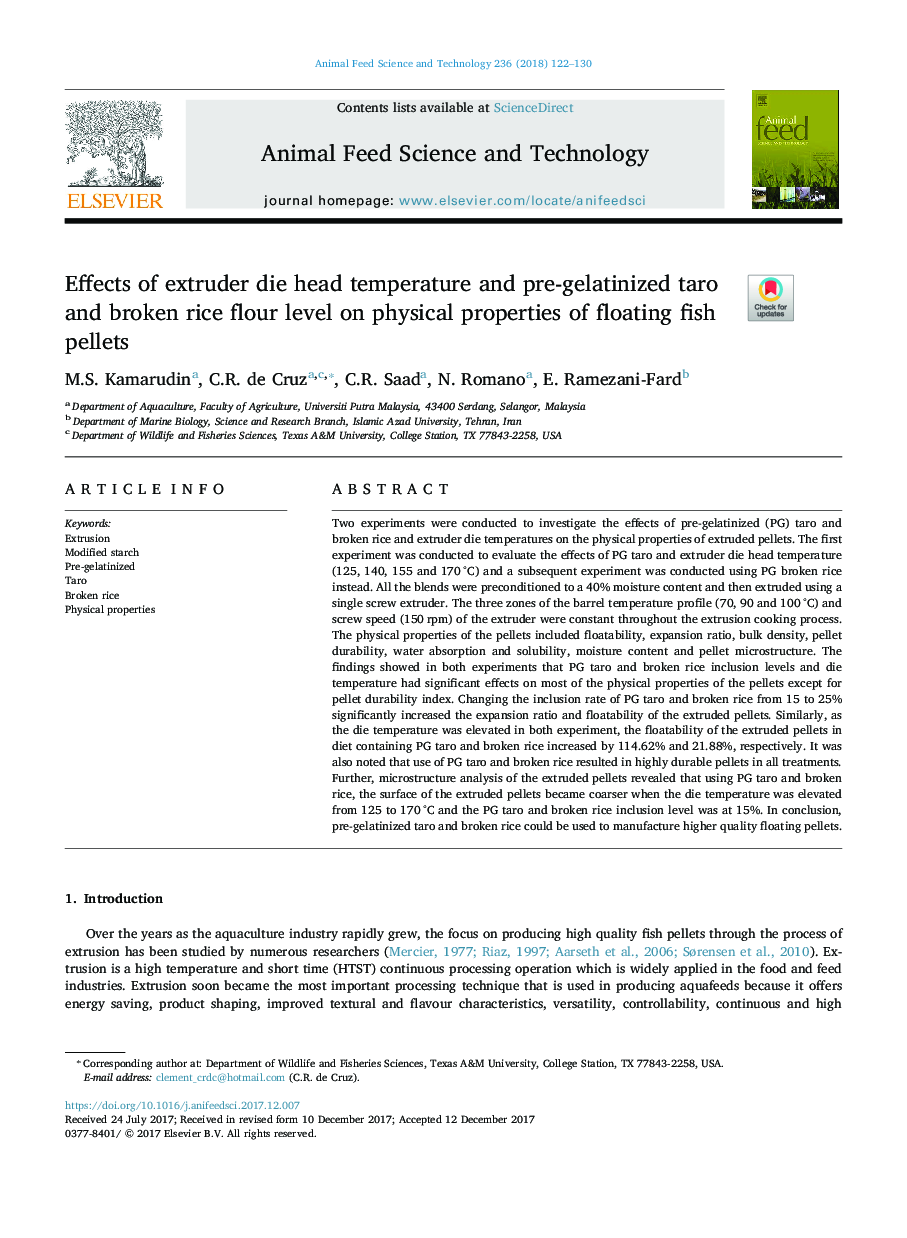| کد مقاله | کد نشریه | سال انتشار | مقاله انگلیسی | نسخه تمام متن |
|---|---|---|---|---|
| 8491050 | 1552350 | 2018 | 9 صفحه PDF | دانلود رایگان |
عنوان انگلیسی مقاله ISI
Effects of extruder die head temperature and pre-gelatinized taro and broken rice flour level on physical properties of floating fish pellets
ترجمه فارسی عنوان
اثرات دمای دم اکسترودر و ترش قبل از ژلاتینی شده و تره آرد برنج بر خواص فیزیکی گلوله های شناور ماهی
دانلود مقاله + سفارش ترجمه
دانلود مقاله ISI انگلیسی
رایگان برای ایرانیان
کلمات کلیدی
اکستروژن، نشاسته اصلاح شده قبل از ژلاتین، تارو، برنج شکسته، مشخصات فیزیکی،
موضوعات مرتبط
علوم زیستی و بیوفناوری
علوم کشاورزی و بیولوژیک
علوم دامی و جانورشناسی
چکیده انگلیسی
Two experiments were conducted to investigate the effects of pre-gelatinized (PG) taro and broken rice and extruder die temperatures on the physical properties of extruded pellets. The first experiment was conducted to evaluate the effects of PG taro and extruder die head temperature (125, 140, 155 and 170â¯Â°C) and a subsequent experiment was conducted using PG broken rice instead. All the blends were preconditioned to a 40% moisture content and then extruded using a single screw extruder. The three zones of the barrel temperature profile (70, 90 and 100â¯Â°C) and screw speed (150â¯rpm) of the extruder were constant throughout the extrusion cooking process. The physical properties of the pellets included floatability, expansion ratio, bulk density, pellet durability, water absorption and solubility, moisture content and pellet microstructure. The findings showed in both experiments that PG taro and broken rice inclusion levels and die temperature had significant effects on most of the physical properties of the pellets except for pellet durability index. Changing the inclusion rate of PG taro and broken rice from 15 to 25% significantly increased the expansion ratio and floatability of the extruded pellets. Similarly, as the die temperature was elevated in both experiment, the floatability of the extruded pellets in diet containing PG taro and broken rice increased by 114.62% and 21.88%, respectively. It was also noted that use of PG taro and broken rice resulted in highly durable pellets in all treatments. Further, microstructure analysis of the extruded pellets revealed that using PG taro and broken rice, the surface of the extruded pellets became coarser when the die temperature was elevated from 125 to 170â¯Â°C and the PG taro and broken rice inclusion level was at 15%. In conclusion, pre-gelatinized taro and broken rice could be used to manufacture higher quality floating pellets.
ناشر
Database: Elsevier - ScienceDirect (ساینس دایرکت)
Journal: Animal Feed Science and Technology - Volume 236, February 2018, Pages 122-130
Journal: Animal Feed Science and Technology - Volume 236, February 2018, Pages 122-130
نویسندگان
M.S. Kamarudin, C.R. de Cruz, C.R. Saad, N. Romano, E. Ramezani-Fard,
